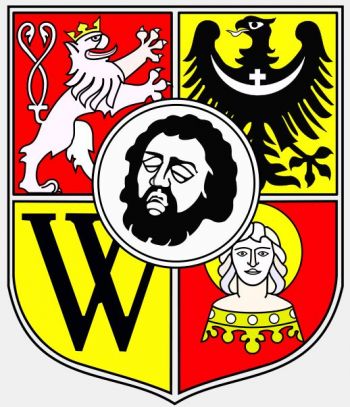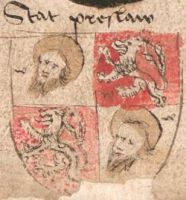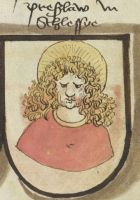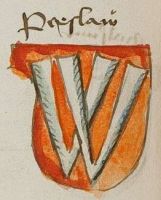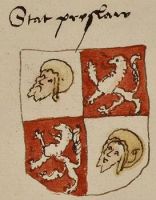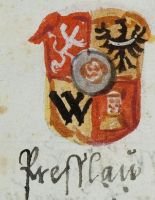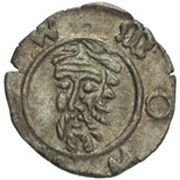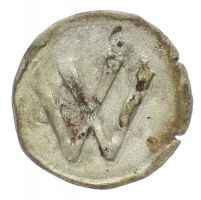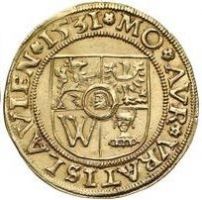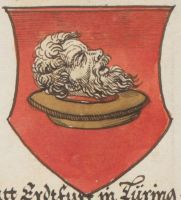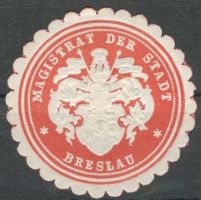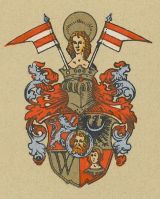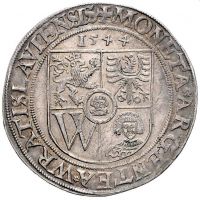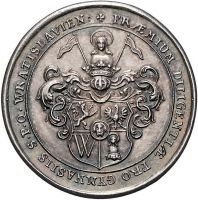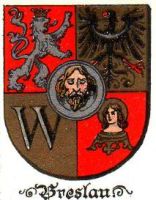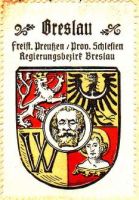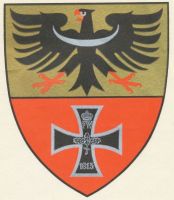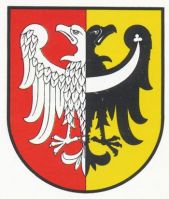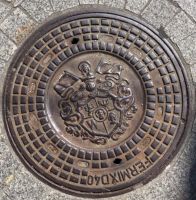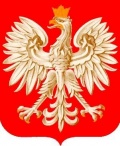Wrocław: Difference between revisions
Knorrepoes (talk | contribs) No edit summary |
Knorrepoes (talk | contribs) |
||
| (22 intermediate revisions by the same user not shown) | |||
| Line 1: | Line 1: | ||
{{ | {| class="wikitable" | ||
|- style="vertical-align:top;" | |||
|[[File:wroclaw.jpg|center|350 px|alt=Coat of arms (crest) of {{PAGENAME}}]] | |||
| | |||
<center>''' {{uc:{{PAGENAME}}}} '''</center><br> | |||
'''Country''' : Poland [[File:Poland.jpg|60 px|right]]<br><br><br><br> | |||
'''Province''' : [[Dolny Śląsk]][[File:Dolnysla.jpg|60 px|right]]<br><br><br><br> | |||
'''Additions''': 1928 [[Psie Pole]] | |||
{{#display_map:51.1082,17.0349|width=250|height=250|zoom=7}} | |||
|} | |||
{| class="wikitable" | |||
|+Official blazon | |||
|- | |||
|'''Polish''' | |||
| blazon wanted | |||
|- | |||
|'''English''' | |||
| blazon wanted | |||
|} | |||
===Origin/meaning=== | ===Origin/meaning=== | ||
Around 1163 the Dukes of Silezia are known to have a castle in what is now Wrocław. In 1225 the village that developed around the castle received city rights. The oldest seal probably dates from the same time and shows the arms of Silezia (eagle with crescent) and the head of St. John Baptist, the patron saint of the city. In 1335 the city became a possession of the kings of Bohemia and the seals of the governors of Wrocław showed quartered arms with the eagle of Silezia, and the lion of [[Bohemia]]. | Around 1163 the Dukes of Silezia are known to have a castle in what is now Wrocław. In 1225 the village that developed around the castle received city rights. The oldest seal probably dates from the same time and shows the arms of Silezia (eagle with crescent) and the head of St. John Baptist, the patron saint of the city. In 1335 the city became a possession of the kings of Bohemia and the seals of the governors of Wrocław showed quartered arms with the eagle of Silezia, and the lion of [[Bohemia]]. | ||
In the 15th and 16th century the above arms gradually developed. The arms show the lion of Bohemia, the eagle of Silezia, the town's initial and the head of St. John the Evangelist, patron saint of the chapel of the city hall. The head of St. John Baptist was added as an escutcheon. These arms were formally granted by Emperor Charles V in 1530 and are still used today. | In the 15th and 16th century the above arms gradually developed. The arms show the lion of Bohemia, the eagle of Silezia, the town's initial (for Wratislava as the town was named in Latin, not for Wrocław, that name only appeared after 1945) and the head of St. John the Evangelist, patron saint of the chapel of the city hall. The head of St. John Baptist was added as an escutcheon. These arms were formally granted by Emperor Charles V in 1530 and are still used today. | ||
In the 19th century the city used the arms with a helmet and crest. The crest showed again the bust of St. John with two banners of the city, see images below. | In the 19th century the city used the arms with a helmet and crest. The crest showed again the bust of St. John with two banners of the city, see images below. | ||
Until 1938 the city used the historical arms, with or without the helmet and crest, as shown by some examples from different books and albums as shown below. | Until 1938 the city used the historical arms, with or without the helmet and crest, as shown by some examples from different books and albums as shown below. | ||
In 1938 the city received new arms from the Nazi government, as the use of saints in arms was considered highly unappropriate. The new arms showed the eagle of Silezia and in the lower half the Iron Cross. This German military cross was founded in 1813 in Wrocław as a result of its resistance against Napoleon. It has been the most used military order in Germany since. | In 1938 the city received new arms from the Nazi government, as the use of saints in arms was considered highly unappropriate. The new arms showed the eagle of Silezia and in the lower half the Iron Cross. This German military cross was founded in 1813 in Wrocław as a result of its resistance against Napoleon. It has been the most used military order in Germany since. | ||
After the war the city became Polish, but the old arms were not restored. In 1948 the city received new arms, a divided shield with the Polish and the Silezian eagle.These arms were used until the mid 1990s, even though the historical arms were finally restored in June 1990 by the city council. | |||
===Image gallery=== | |||
<gallery widths=250px heights=200px perrow=0> | |||
File:wroclaw1475.jpg|alt=Arms (crest) of Wrocław|The arms shown around 1475 | |||
File:Wrocławjr.jpg|alt=\Arms (crest) of Wrocław|The arms in the Armorial Jörg Rügen (1495) | |||
File:Wrocław1514.jpg|alt=Arms (crest) of Wrocław|The arms in a manuscript from 1514 | |||
File:wroclawrp.jpg|alt=Arms (crest) of Wrocław|The arms in the Armorial Ribeaupierre (16th century) | |||
File:Wrocław16.jpg|alt=Arms (crest) of Wrocław|The arms in a [[:Category:Windhag city arms|16th century manuscript]] | |||
File:wroclawc1.jpg|alt=Arms (crest) of Wrocław|Coin from 1419-1437 with only the head of St. John | |||
File:wroclawc2.jpg|alt=Arms (crest) of Wrocław|Coin from 1511-1516 with only the letter W | |||
File:wroclawc3.jpg|alt=Arms (crest) of Wrocław|Coin from 1531 with the new arms | |||
File:wroclaw1576.jpg|alt=Arms (crest) of Wrocław|The arms in a manuscript from 1576 | |||
File:wroclawz1.jpg|alt=Arms (crest) of Wrocław|Seal of Wrocław from around 1900 | |||
File:wroclawz2.jpg|alt=Arms (crest) of Wrocław|Seal of Wrocław from around 1900 | |||
File:wroclaw5.jpg|alt=Arms (crest) of Wrocław|Image of the arms used around 1900 | |||
File:Wrocławc2.jpg|alt=Arms (crest) of Wrocław|The arms on a 1544 coin | |||
File:Wrocławc1.jpg|alt=Arms (crest) of Wrocław|The arms on a 1645 coin | |||
File:Wrocławc3.jpg|alt=Arms (crest) of Wrocław|The arms on a 1741 coin | |||
File:wroclaw3.jpg|alt=Arms (crest) of Wrocław|Arms of Wrocław from around 1900 | |||
File:breslau.hagd.jpg|alt=Arms (crest) of Wrocław|The arms by [[Otto Hupp|Hupp]] in the [[Kaffee Hag albums]] +/- 1925 | |||
File:wroclaw1.jpg|alt=Arms (crest) of Wrocław|Arms of Wrocław from the Abdulla albums, 1928 | |||
File:wroclaw7.jpg|alt=Arms (crest) of Wrocław|The arms of Wrocław from 1938 | |||
File:wroclaw6.jpg|alt=Arms (crest) of Wrocław|The arms of Wrocław from 1948 | |||
File:wroclawm.jpg|alt=Arms (crest) of Wrocław|The arms on a manhole cover | |||
</gallery> | |||
[[Literature]] : Louda, 1966; Hupp, 1920s, Plewako & Wanag, 1994; anon. 1939 (?) Die Entwicklung des Wappens der Hauptstadt Breslau. | |||
{{pl}} | |||
{{media}} | {{media}} | ||
[[Category:Polish Municipalities W]] | |||
[[Category:Dolny Śląsk]] | [[Category:Dolny Śląsk]] | ||
[[Category:Wrocław]] | [[Category:Wrocław]] | ||
Revision as of 11:19, 19 June 2024
|
Country : Poland Province : Dolny Śląsk Additions: 1928 Psie Pole
|
| Polish | blazon wanted |
| English | blazon wanted |
Origin/meaning
Around 1163 the Dukes of Silezia are known to have a castle in what is now Wrocław. In 1225 the village that developed around the castle received city rights. The oldest seal probably dates from the same time and shows the arms of Silezia (eagle with crescent) and the head of St. John Baptist, the patron saint of the city. In 1335 the city became a possession of the kings of Bohemia and the seals of the governors of Wrocław showed quartered arms with the eagle of Silezia, and the lion of Bohemia.
In the 15th and 16th century the above arms gradually developed. The arms show the lion of Bohemia, the eagle of Silezia, the town's initial (for Wratislava as the town was named in Latin, not for Wrocław, that name only appeared after 1945) and the head of St. John the Evangelist, patron saint of the chapel of the city hall. The head of St. John Baptist was added as an escutcheon. These arms were formally granted by Emperor Charles V in 1530 and are still used today.
In the 19th century the city used the arms with a helmet and crest. The crest showed again the bust of St. John with two banners of the city, see images below.
Until 1938 the city used the historical arms, with or without the helmet and crest, as shown by some examples from different books and albums as shown below.
In 1938 the city received new arms from the Nazi government, as the use of saints in arms was considered highly unappropriate. The new arms showed the eagle of Silezia and in the lower half the Iron Cross. This German military cross was founded in 1813 in Wrocław as a result of its resistance against Napoleon. It has been the most used military order in Germany since.
After the war the city became Polish, but the old arms were not restored. In 1948 the city received new arms, a divided shield with the Polish and the Silezian eagle.These arms were used until the mid 1990s, even though the historical arms were finally restored in June 1990 by the city council.
Image gallery
The arms in a 16th century manuscript
The arms by Hupp in the Kaffee Hag albums +/- 1925
Literature : Louda, 1966; Hupp, 1920s, Plewako & Wanag, 1994; anon. 1939 (?) Die Entwicklung des Wappens der Hauptstadt Breslau.
Poland heraldry portal
This page is part of the Poland heraldry portal |
Heraldry of the World |
|
Civic heraldry:
|
Other heraldry: |
Contact and Support
Partners:
Your logo here ?
Contact us
© 1995-2025, Heraldry of the World, Ralf Hartemink 
Index of the site
